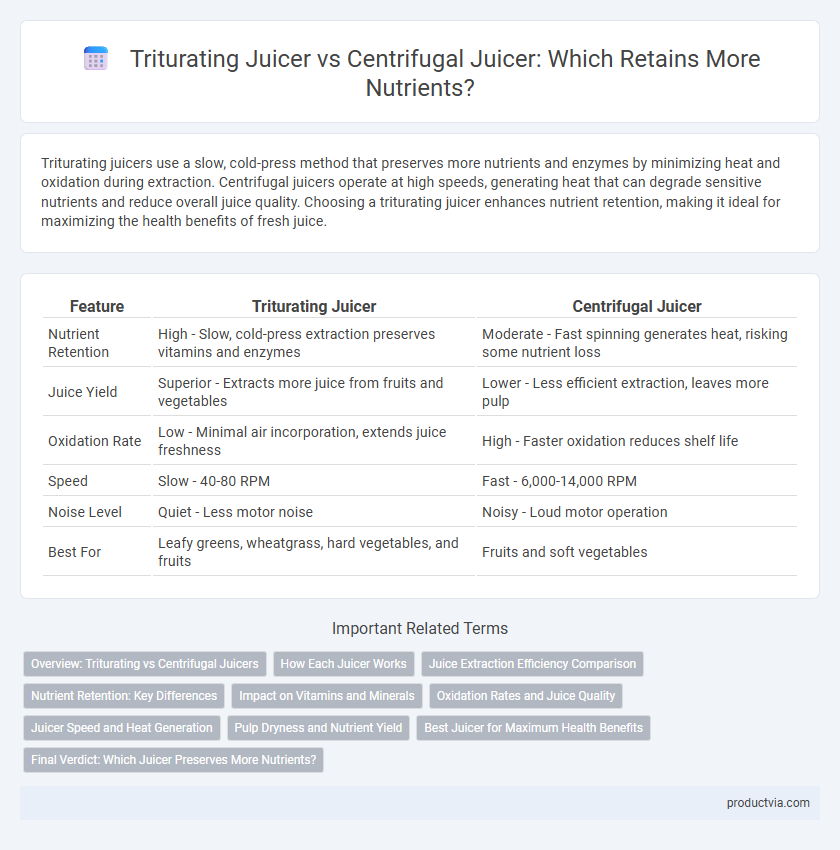Triturating juicers use a slow, cold-press method that preserves more nutrients and enzymes by minimizing heat and oxidation during extraction. Centrifugal juicers operate at high speeds, generating heat that can degrade sensitive nutrients and reduce overall juice quality. Choosing a triturating juicer enhances nutrient retention, making it ideal for maximizing the health benefits of fresh juice.
Table of Comparison
| Feature | Triturating Juicer | Centrifugal Juicer |
|---|---|---|
| Nutrient Retention | High - Slow, cold-press extraction preserves vitamins and enzymes | Moderate - Fast spinning generates heat, risking some nutrient loss |
| Juice Yield | Superior - Extracts more juice from fruits and vegetables | Lower - Less efficient extraction, leaves more pulp |
| Oxidation Rate | Low - Minimal air incorporation, extends juice freshness | High - Faster oxidation reduces shelf life |
| Speed | Slow - 40-80 RPM | Fast - 6,000-14,000 RPM |
| Noise Level | Quiet - Less motor noise | Noisy - Loud motor operation |
| Best For | Leafy greens, wheatgrass, hard vegetables, and fruits | Fruits and soft vegetables |
Overview: Triturating vs Centrifugal Juicers
Triturating juicers operate with slow, dual-stage pressing mechanisms that maximize nutrient retention by minimizing heat and oxidation. Centrifugal juicers use high-speed spinning blades that generate heat and expose juice to air, often leading to nutrient degradation. The triturating process preserves higher levels of vitamins, enzymes, and antioxidants compared to the rapid extraction in centrifugal juicers.
How Each Juicer Works
Triturating juicers operate by slowly grinding and crushing fruits and vegetables, preserving more vitamins, enzymes, and antioxidants through minimal heat and oxidation. Centrifugal juicers use high-speed spinning blades to shred produce and extract juice quickly but generate heat and expose juice to more air, which can degrade sensitive nutrients. The slow, cold-press method of triturating juicers results in higher nutrient retention compared to the fast, heat-producing process of centrifugal juicers.
Juice Extraction Efficiency Comparison
Triturating juicers use a slow, cold-press mechanism that minimizes oxidation and heat, preserving more vitamins, enzymes, and antioxidants compared to centrifugal juicers. Centrifugal juicers operate at high speeds, generating heat that can degrade delicate nutrients and reduce overall juice quality. Studies show triturating juicers extract up to 20-30% more juice with higher nutrient retention, making them more efficient for maximizing health benefits from fruits and vegetables.
Nutrient Retention: Key Differences
Triturating juicers use slow, cold-press extraction that preserves maximum vitamins, enzymes, and antioxidants by minimizing heat and oxidation. Centrifugal juicers operate at high speeds, generating heat and introducing air which leads to faster nutrient degradation and reduced vitamin C and enzyme levels. Studies show triturating juicers retain up to 40% more nutrients compared to centrifugal juicers, making them superior for health-focused juice extraction.
Impact on Vitamins and Minerals
Triturating juicers excel in nutrient retention by slowly crushing fruits and vegetables, preserving delicate vitamins like vitamin C and enzymes sensitive to heat and oxidation. Centrifugal juicers, operating at high speeds, generate heat and introduce air, which can degrade heat-sensitive nutrients and reduce mineral bioavailability. Studies indicate that triturating juicers maintain higher levels of antioxidants, vitamins, and minerals compared to centrifugal juicers, enhancing overall nutrient absorption.
Oxidation Rates and Juice Quality
Triturating juicers operate at slower speeds, significantly reducing oxidation rates and preserving higher levels of vitamins, enzymes, and antioxidants compared to centrifugal juicers. The cold-press mechanism in triturating juicers minimizes heat generation, ensuring superior juice quality with richer flavor and longer shelf life. Conversely, centrifugal juicers, with their high-speed blades, introduce more air into the juice, accelerating nutrient degradation and lowering overall nutritional value.
Juicer Speed and Heat Generation
Triturating juicers operate at slower speeds, typically around 80-100 RPM, minimizing heat generation and oxidation that can degrade sensitive nutrients and enzymes in juice. In contrast, centrifugal juicers run at much higher speeds, up to 6,000-14,000 RPM, producing significant heat and aeration, which accelerates nutrient loss and reduces juice shelf life. Lower operational speed and reduced heat in triturating juicers contribute to superior nutrient retention and fresher-tasting juice.
Pulp Dryness and Nutrient Yield
Triturating juicers excel in nutrient retention by slowly crushing fruits and vegetables, resulting in drier pulp and higher nutrient yield compared to centrifugal juicers. Centrifugal juicers operate at high speeds, producing wetter pulp and increased oxidation, which reduces overall nutrient content. The slow, cold-press mechanism of triturating juicers preserves enzymes and vitamins more effectively, making them superior for nutrient-rich juice extraction.
Best Juicer for Maximum Health Benefits
Triturating juicers, also known as masticating juicers, excel in nutrient retention by slowly crushing and pressing fruits and vegetables, preserving enzymes and vitamins better than centrifugal juicers which use high-speed spinning blades that generate heat and oxidation. The lower heat and slower extraction process of triturating juicers minimize nutrient degradation, making them the best choice for maximum health benefits and enhanced juice quality. Studies show that juices from masticating juicers retain higher levels of vitamin C, antioxidants, and phytochemicals, supporting optimal nutrient absorption and antibody defense.
Final Verdict: Which Juicer Preserves More Nutrients?
Triturating juicers, also known as masticating juicers, operate at slower speeds using an auger to crush and press fruits and vegetables, preserving higher levels of enzymes, vitamins, and antioxidants due to minimal heat and oxidation. Centrifugal juicers spin at high speeds, generating heat and exposing juice to more air, which can lead to nutrient degradation and a shorter shelf life. For optimal nutrient retention, triturating juicers are the superior choice, offering fresher, more nutrient-dense juice ideal for health-conscious consumers.
Triturating juicer vs centrifugal juicer for nutrient retention Infographic

 productvia.com
productvia.com